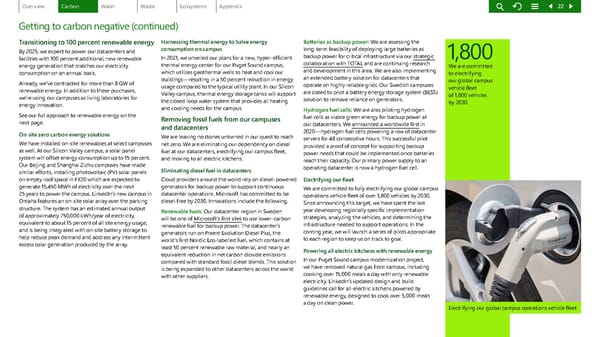Transitioning to 100 percent renewable energy By 2025, we expect to power our datacenters and facilities with 100 percent additional, new renewable energy generation that matches our electricity consumption on an annual basis. Already, we’ve contracted for more than 8 GW of renewable energy. In addition to these purchases, we’re using our campuses as living laboratories for energy innovation. See our full approach to renewable energy on the next page. On-site zero carbon energy solutions We have installed on-site renewables at select campuses as well. At our Silicon Valley campus, a solar panel system will offset energy consumption up to 15 percent. Our Beijing and Shanghai Zizhu campuses have made similar efforts, installing photovoltaic (PV) solar panels on empty roof space in FY20 which are expected to generate 15,450 MWh of electricity over the next 25 years to power the campus. LinkedIn’s new campus in Omaha features an on-site solar array over the parking structure. The system has an estimated annual output of approximately 750,000 kWh/year of electricity, equivalent to about 15 percent of all site energy usage, and is being integrated with on-site battery storage to help reduce peak demand and address any intermittent excess solar generation produced by the array. Harnessing thermal energy to halve energy consumption on campus In 2021, we unveiled our plans for a new, hyper-efficient thermal energy center for our Puget Sound campus, which utilizes geothermal wells to heat and cool our buildings—resulting in a 50 percent reduction in energy usage compared to the typical utility plant. In our Silicon Valley campus, thermal energy storage tanks will support the closed loop water system that provides all heating and cooling needs for the campus. Removing fossil fuels from our campuses and datacenters We are leaving no stones unturned in our quest to reach net zero. We are eliminating our dependency on diesel fuel at our datacenters, electrifying our campus fleet, and moving to all electric kitchens. Eliminating diesel fuel in datacenters Cloud providers around the world rely on diesel-powered generators for backup power to support continuous datacenter operations. Microsoft has committed to be diesel-free by 2030. Innovations include the following. Renewable fuels: Our datacenter region in Sweden will be one of Microsoft’s first sites to use lower-carbon renewable fuel for backup power. The datacenter’s generators run on Preem Evolution Diesel Plus, the world’s first Nordic Eco-labelled fuel, which contains at least 50 percent renewable raw material, and nearly an equivalent reduction in net carbon dioxide emissions compared with standard fossil diesel blends. This solution is being expanded to other datacenters across the world with other suppliers. Getting to carbon negative (continued) Batteries as backup power: We are assessing the long-term feasibility of deploying large batteries as backup power for critical infrastructure via our strategic collaborat ion with TOTAL and are continuing research and development in this area. We are also implementing an extended battery solution for datacenters that operate on highly reliable grids. Our Swedish campuses are slated to pilot a battery energy storage system (BESS) solution to remove reliance on generators. Hydrogen fuel cells: We are also piloting hydrogen fuel cells as viable green energy for backup power at our datacenters. We announced a worldwide first in 2020—hydrogen fuel cells powering a row of datacenter servers for 48 consecutive hours. This successful pilot provided a proof of concept for supporting backup power needs that could be implemented once batteries reach their capacity. Our primary power supply to an operating datacenter is now a hydrogen fuel cell. Electrifying our fleet We are committed to fully electrifying our global campus operations vehicle fleet of over 1,800 vehicles by 2030. Since announcing this target, we have spent the last year developing regionally specific implementation strategies, analyzing the vehicles, and determining the infrastructure needed to support operations. In the coming year, we will launch a series of pilots appropriate to each region to keep us on track to goal. Powering all electric kitchens with renewable energy In our Puget Sound campus modernization project, we have removed natural gas from campus, including cooking over 15,000 meals a day with only renewable electricity. LinkedIn’s updated design and build guidelines call for all-electric kitchens powered by renewable energy, designed to cook over 5,000 meals a day on clean power. 1,800 We are committed to electrifying our global campus vehicle fleet of 1,800 vehicles by 2030. Electrifying our global campus operations vehicle fleet. 22
 Environmental Sustainability Report | Microsoft Page 21 Page 23
Environmental Sustainability Report | Microsoft Page 21 Page 23